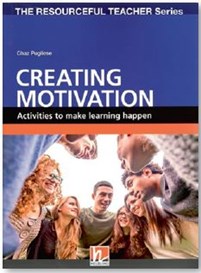Creating Motivation, Helbling Publishing
Chaz Pugliese
Helbling Publishing
See page 87 for details

We cannot really motivate others. Our job is to set up a positive learning environment and provide relevant contexts; the students’ responsibility is to be open to the opportunities that learning provides. So says the teacher-writer of Creating Motivation, and he gives us tips and tasks that have worked for him over the years.
In chapter one, Group Processes, the aim is to provide a collaborative, safe environment. The activities focus on trust and acceptance. There are many ‘old friends’, but also some activities I have never seen.
The first, Two People, One Pen(cil), has the students working in pairs to write down a dictation. But unlike most dictations, the students have only one pen between them and they both have to have their hands on the pen when they are writing! The second task I liked was an interesting take on Find someone who… . Students have to write down whether or not something read out by the teacher is true for them. They then share their ideas. For example, a student may write ‘I am a night owl’ under a This is not me heading, whereas someone else might write it under This is definitely me. It makes for an interesting starting point for discussions.
There were a number of activities involving sound and touch as well as noticing tasks. One I remember from my childhood is Changes, where your partner has to have eyes closed while you alter your appearance in some way, then eyes open your partner has to tell you what you have changed! I would have a difficult time doing this activity in my class given all of my students wear thobes, but it would certainly work in a class with more variety in their dress.
To include yourself in the Getting to Know you phase of a lesson, the students write random questions and interview the teacher to satisfy their curiosity. If you prefer, you can add the caveat that the questions must be in a certain tense for specific language practice. There were a number of other lovely tasks in this chapter but I will leave you to explore them for yourself.
In chapter 2, Priming, the focus is on getting the students to be alert and ready for the lesson, which includes having them reflect on their individual needs (Am I hot? Am I hungry? Do I need some water?) and to share their thoughts with a classmate. Another task is one I do myself on a regular basis. Cell Phone Break allows students a two-minute break to check their texts before they have to put their phones away. This acknowledges our need to communicate with family and friends but also establishes rules for classroom behaviour. I often give students another break mid-way through a lesson to help them relax for a moment before launching into the next activity.
The last chapter, Stimulate and Surprise, is all about finding ‘creative meaningful learning moments’. The idea of stimulating and surprising students is to keep them motivated and jolt them into learning. For example, students write messages to one another, such as writing a response to a piece of art they have seen under the heading, Same or different?, or What’s the right caption?, which is actually ideal for my purposes as I have just been to a Picasso exhibition here in Qatar and am trying to encourage my students to go. Having them look at some photos of the art and asking them to use comparative adjectives to describe them would match this week’s theme perfectly!
Other interesting tasks include Things that I want, which is a reflective writing task about goal setting; Are we what we do? which is a way of analysing personal routines; and CV of failures. I particularly like the last one as it gives students the opportunity to reflect how we can learn from our mistakes.
This book is a gem. I suspect I will be hauling it off my shelf again and again.
Sandee Thompson
Sandee Thompson is a teacher at the College of the North Atlantic in Qatar and a CELTA tutor.
Comments
Write a Comment
Comment Submitted